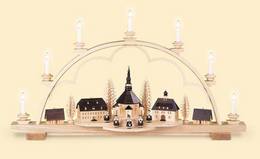Candle Arches
 The German light or candle arch, also known as the German Erzgebirge Schwibbogen, is one of the oldest collectible items from the Black Forest region. What started in 1726 crafted from iron has become one of the most popular and beautiful productions in the entire world. Schwibbogen originates from the German word Schwebebogen which means “floating arch”. Many older German cities such as Passau and Regensburg still have medieval arches made in the Schwebebogen gothic architectural designs.
The German light or candle arch, also known as the German Erzgebirge Schwibbogen, is one of the oldest collectible items from the Black Forest region. What started in 1726 crafted from iron has become one of the most popular and beautiful productions in the entire world. Schwibbogen originates from the German word Schwebebogen which means “floating arch”. Many older German cities such as Passau and Regensburg still have medieval arches made in the Schwebebogen gothic architectural designs.
During the 18th century, many Erzgebirge miners would hang their pit lamps on the entry holes on the last working shift before Christmas. This started what is now the tradition of using Schwibbogen arches in Christmas décor. The earlier light hanging was a representation of the miners who would wish for the light that they did not have during their long work days. The earlier candle arches had many different numbers of lights, although they all held odd numbers of lights in their designs. This design makes it possible for one light to be the center of the Schwibbogen arch, which is the design that collectors love today.
Most of the Schwibbogen from the earlier years were made with iron. Wood became a popular design for candle arches in the Erzgebirge, Black Forest region due to the bountifulness of wood. During the 20th century, most candle arch designs were produced using wood as the main material.
During a trade fair in 1937, the mayors of Erzgebirge proclaimed that the typical Erzgebirge candle arches should be the logo of the trade fair and commissioned craftsmen from the area to build very large, oversized Schwibbogen to place in the center of all the towns so that they could be seen by visitors. This act made the Schwibbogen very popular throughout Germany and eventually all over the world. Today many German and particularly Erzgebirge towns will still set up an oversized candle arch in remembrance of the era that made the candle arch so popular.
The light arches that we see today often depict religious scenes such as the nativity scene, Christmas carolers and churches. There are also beautiful arches that represent nature with forests and wild animals or local scenes from the Seiffen region such as the local Christmas fair, the Seiffen Church or various towns in the Erzgebirge region. These light arches are illuminated by candlelight or by electricity.

